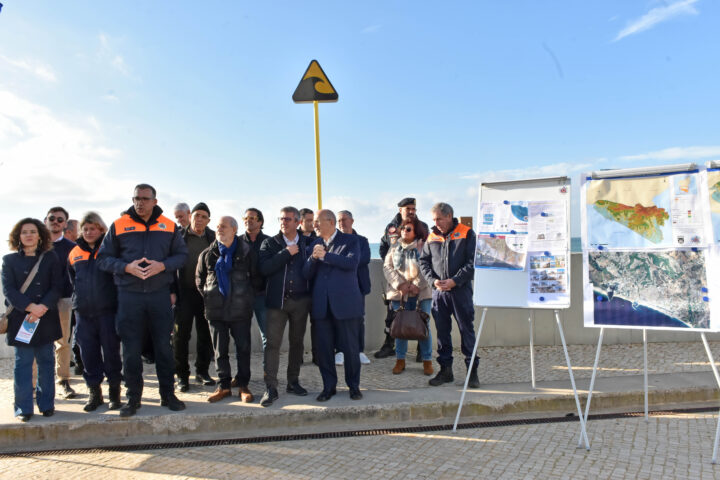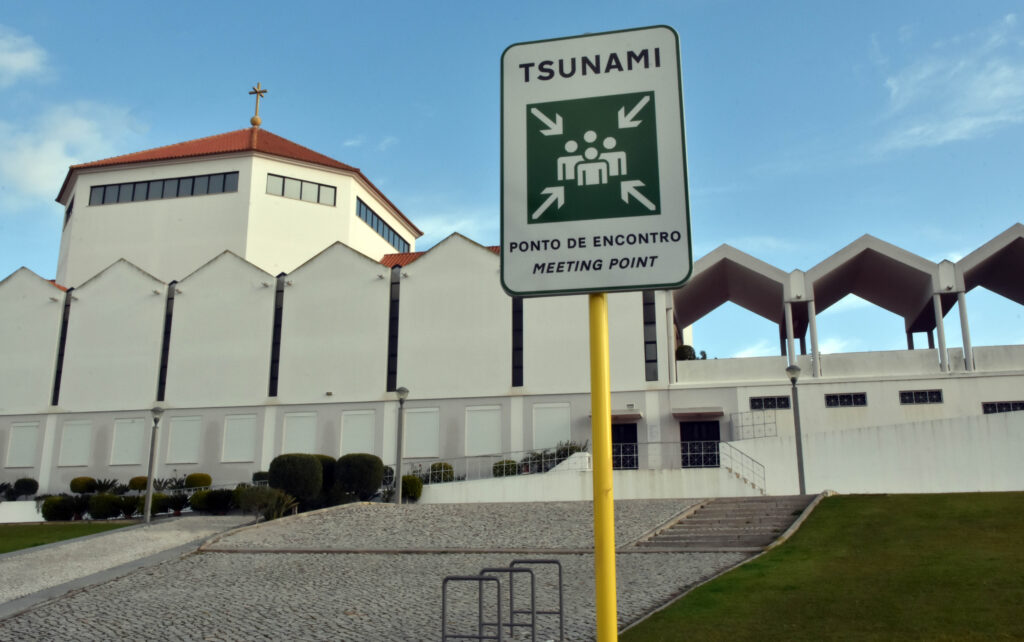Quarteira, one of the most vulnerable territories on the Portuguese coast, is, from now on, more prepared for a tsunami scenario. The Municipal Council of Loulé presented yesterday morning, next to the beach, the signage project for evacuation routes due to the risk of tsunami for this parish and the population awareness plan.
This is a project developed by the Municipality, through its Municipal Civil Protection Service, in partnership with the team coordinated by Carlos Oliveira, from Instituto Superior Técnico, who collaborated in carrying out the preliminary study and all monitoring of the work.
It was a “network”, as explained by Loulé Civil Protection coordinator João Matos Lima, considering the involvement of the Quarteira Parish Council, Vilamoura Marina, Maritime Authority and GNR in this entire process. “Civil Protection must be understood as an activity that shares resources, responsibilities and knowledge”.
In addition to the 140 evacuation route signs that are now spread throughout Quarteira/Vilamoura, 13 meeting points were created located outside the floodable area, considered safe places as they are located in higher areas, such as the Church of S. Pedro do Mar, the Drª Francisca de Aragão and Drª Laura Ayres Schools or Avenida Papa Francisco.
The plan also included six sound warning posts, which will be heard in the event of an alert.
In the signage, distances were placed and a map of these distances was created, as the objective is that, in the event of evacuation, people have no doubts and can reach the meeting point as quickly as possible. “We tried to place the strictly necessary signs, so that there would be no mistake”, stressed coach Fernando Leandro.
However, evacuation routes are not always the shortest, but rather the safest, as they take into account the vulnerability of the building.
As Tatiana Neves, from the Loulé Civil Protection Service, explained, these works were carried out “using our worst-case scenario, which would be a 15 meter wave, taking as a reference what happened in 1755”.
This plan took into account seasonality issues and the number of people who are on the beach during the summer.
In Vilamoura, as the ground is essentially flat, shelters are planned to be built at a height, especially in the Praia da Falésia area, as “in flat areas, the water spreads out much more and it is necessary to walk to reach higher areas to evacuate the population”, noted Carlos Oliveira.

This project is georeferenced, thus allowing signage to be updated in the event of vandalism or, given the city's growth, making it possible to change evacuation routes.
After implementing the signage, we now enter the dissemination and awareness phase. To this end, a bilingual leaflet (Portuguese/English) is being created and the aim is now to promote actions among the population, also taking into account the hotel industry, particularly in flood zones, and then channeling this information to the many tourists who visit Quarteira.
“It’s not enough to do it. The last step is to pass on all this information to the population. People need to know how to behave. Actions in the field, for example with schools, are essential for people to understand how the signage is made”, said the Técnico teacher.
Signage plans like the one in Quarteira already exist in cities like Portimão, Cascais or Lisbon, but here “we managed to innovate in some points”, said Carlos Oliveira.
This signage implementation project on the coast of the municipality of Loulé will have a second phase, which is currently in preparation, and concerns the parish of Almancil which, with Quarteira, totals 14 kilometers of seafront.
Two days after a new meteorological radar was inaugurated within the municipality, for Vítor Aleixo this system presented today reinforces the “safety culture in the municipality”.
“The security of human communities is one of the first responsibilities of public authorities. The majority of the population lives on the coast and Portugal is no exception. In recent years we have done systematic work to prepare ourselves for an unexpected and tragic moment that occurs, be it an earthquake, a tsunami, a storm or an unlimited drought with disastrous consequences. Our first commitment is to life!”, assured the mayor.
This project is based on the National Strategy for Preventive Civil Protection 2030.


















Comments